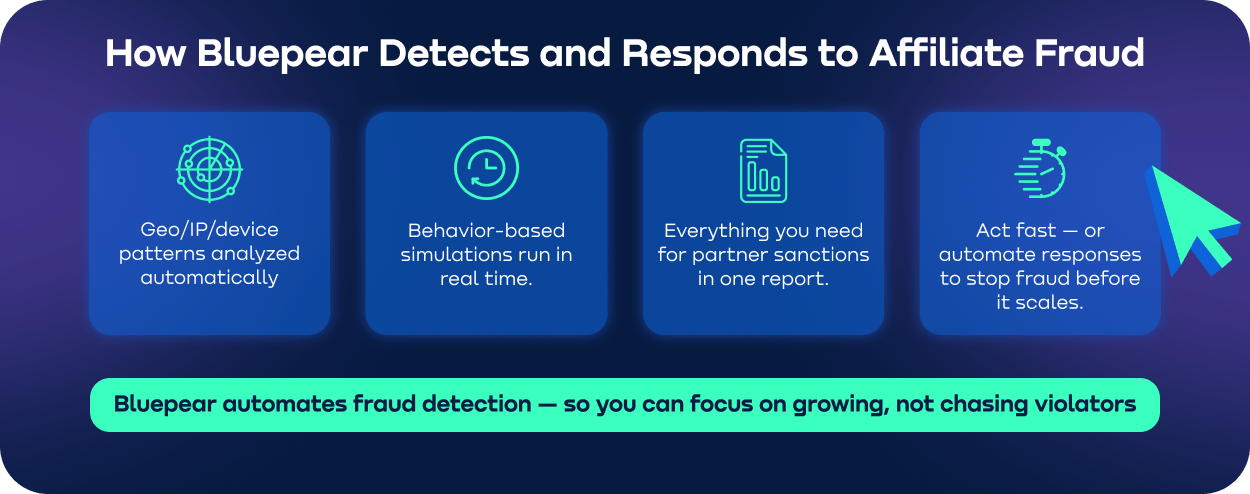
Contents
In 2025, affiliate fraud and affiliate click fraud have become mainstream threats to marketing budgets and brand trust. Fraudsters now exploit tracking loopholes, inflate traffic, and hijack payouts without delivering real value — all while appearing legitimate to standard systems.
Basic fraud filters and manual reviews can’t keep up. Detecting these tactics now demands behavioural analytics and purpose-built tools like Bluepear, which combines session tracking, attribution checks, and brand fraud detection to ensure comprehensive protection across affiliate channels.
The 7 Most Common Types of Affiliate Marketing Fraud
In 2025, affiliate programs face a growing threat landscape, where attackers constantly adapt to bypass detection. Understanding the most common types of affiliate fraud is the first step to protecting your campaigns — whether it's technical manipulation or brand fraud, all tactics share one goal: diverting spend from genuine conversions. Below, you’ll find the most widespread schemes.
Cookie Stuffing
Cookie stuffing is a classic affiliate fraud and affiliate click fraud tactic still active in 2025. It secretly drops multiple cookies on a user’s browser without consent — often via iframes, JavaScript, or image pixels — so that fraudsters can claim commissions on unrelated future purchases.
For example, a user visits a blog, and hidden code injects cookies from various affiliate programs. If they book a hotel days later, the fraudster gets paid. This scheme distorts attribution, increases acquisition costs, and, according to TrackAd, accounts for up to 60% of affiliate fraud cases.
Bluepear detects cookie stuffing and affiliate click fraud using behavioural fingerprinting and real-time session tracking.
Brand Bidding
Brand bidding is a deceptive affiliate fraud and affiliate click fraud tactic where affiliates use branded keywords to divert traffic and earn unearned commissions. Users searching branded terms may click affiliate ads mimicking the brand and complete purchases.
This affiliate fraud raises CPC, cannibalises direct traffic, and can cause brand fraud with misleading language. It violates affiliate agreements as affiliate violating behaviour.
Alloy’s State of UK Fraud Report (2025) found 38% of UK fintechs lost £1m–£5m to fraud from Oct 2023 to 2024.
Bluepear detects branded keyword abuse, flags suspicious ads and redirects, and helps maintain a brand safe ad network with anti ad fraud and brand fraud detection tools.
Typosquatting
Typosquatting, or URL hijacking, involves registering domains that closely resemble a brand’s website, differing by one character. Fraudsters use these lookalike domains to impersonate the brand, capture traffic, or insert affiliate links stealing conversion credit.
Users mistype a brand’s URL and reach a fake site that mimics the real one, redirecting traffic through affiliate links. This enables affiliate fraud, causes brand fraud, reputational damage, and phishing risks. A 2019 Palo Alto Networks study found nearly 13,857 typosquatting domains targeting top websites. WIPO reported 1,929 cybersquatting cases in 2024.
Bluepear scans domains, cross-checks DNS, WHOIS, and redirects to flag risky traffic linked to typosquatting — strengthening brand fraud detection systems in the process.
Click Injection
Click injection is a form of mobile affiliate fraud where malicious apps monitor device activity and inject fake clicks just before a real app install occurs. This makes it appear as if the fraudulent affiliate was the source of the install, allowing them to claim commission on conversions they didn’t drive.
A user installs a legitimate app on their phone. A previously installed background app detects the install event and immediately sends a fake click to the attribution platform. Because the timing is so close to the real install, the fraudster’s click gets credit.
This tactic disproportionately affects mobile campaigns. It inflates acquisition costs, pollutes campaign metrics, and deprives legitimate affiliates or media partners of deserved credit.
Click fraud continues to be a major concern for marketers. According to CHEQ, the total cost of ad fraud reached $61 billion in 2022, with an estimated 14% of all clicks on paid search campaigns originating from non-genuine sources.
Bluepear combats click injection by analysing the time-to-install curve — the gap between click and conversion — across devices and affiliates. Its anomaly detection engine flags patterns where installs consistently follow clicks within unrealistic time frames.
Traffic Laundering
Traffic laundering involves routing fake or low-quality traffic through seemingly legitimate sites to disguise its origin. By the time it reaches the advertiser, it appears to be clean, making detection difficult. Fraudsters use redirect chains via expired blogs, content farms, or shell sites. These act as a mask, allowing bad traffic to pass through affiliate links unnoticed. This form of fraud distorts analytics, inflates spend, and increases exposure to brand fraud, especially when unsafe or policy-violating sources are involved.
Digital ad fraud caused global losses of $81bn in 2022, with one in 13 app installs worldwide being fraudulent — often disguised via redirect chains or intermediary domains. Bluepear maps full traffic paths and filters out unauthorised sources. It detects laundering by flagging unusual referral chains and isolating traffic from domains outside your compliance list.
Conversion Hijacking
Conversion hijacking is a stealthy form of affiliate fraud where bad actors intercept postback signals — server-to-server messages confirming conversions—and inject their affiliate ID to claim credit for sales or installs they didn’t generate.
Fraudsters exploit unsecured tracking links by sending fake postbacks just before or alongside real ones, hijacking payouts. This causes brands to lose money to worthless affiliates while real partners are under-credited, leading to flawed reporting and poor optimisation, and increased risk of brand fraud.
Conversion hijacking made up 0.5% of social engineering attacks in 2023, up from 0.3% in 2022 — a nearly 70% increase. Though exact numbers in affiliate marketing are hard to measure, the tactic is growing.
Bluepear verifies postbacks using timestamp validation, source matching, and handshake checks, flagging mismatches and blocking fraudulent attributions in real time to ensure effective affiliate fraud prevention. These efforts support real-time brand fraud detection during conversion flows.
Affiliate Collusion
Affiliate collusion occurs when two or more affiliates coordinate to manipulate conversions, inflate traffic, or bypass program rules. Unlike solo fraud, this scheme spreads suspicious activity across multiple accounts, making it harder to detect.
Fraudsters may split commissions, rotate referral links, or alternate traffic between accounts to avoid thresholds or penalties. In some cases, fake users or lead farms are shared to generate volume across several IDs.
This type of fraud leads to systematic budget leakage, broken attribution logic, and loss of trust in performance-based partnerships.
Research from ACFE and KPMG shows that up to 50% of all fraud cases involve collusion, and the average loss in such cases is over 2.5 times higher than single-actor fraud. While this data focuses on corporate settings, it reflects the growing risk of affiliate collusion in performance marketing — particularly as networks become more decentralised.
Bluepear uses cross-account analytics to detect suspicious overlap in IPs, devices, timing, and conversion flows. By clustering affiliate activity and scoring behavioural similarities, it flags networks of colluding partners and stops coordinated abuse before it scales.
Key Metrics to Spot Affiliate Fraud Early
Detecting affiliate fraud before it drains your budget requires more than basic analytics. Many schemes including affiliate click fraud now bypass standard PPC tools by mimicking real behaviour or blending into legitimate traffic sources.
Warning signs include:
• Unusually high CTR with low CR
• Sudden surges in traffic from unfamiliar GEOs or outdated devices
• Conversion patterns with identical timestamps or IP clusters
• Traffic spikes during inactive campaign hours
While these red flags may seem minor alone, combined they often signal underlying this fraud activity — especially in automated or multi-account attacks.
Most default ad platforms lack the depth to trace these patterns across sessions, devices, or affiliates. That’s why advanced solutions like affiliate marketing fraud detection systems are essential to isolate abnormal trends, enrich behavioural data, and reveal what conventional tracking misses.
How Bluepear Detects Affiliate Fraud Others Miss
Unlike generic analytics tools, Bluepear is built specifically to uncover hidden layers of affiliate fraud and affiliate click fraud — using behavioural modelling, real-time session tracking, and attribution logic validation.
What it tracks:
• Click-to-conversion timelines and unnatural delays
• Device fingerprint collisions across multiple affiliate accounts
• Suspicious redirect chains and laundering patterns
• Anomalies in postback timing, traffic source consistency, and user behaviour

Bluepear acts as a real-time filter, not just a reporting tool. It flags abnormal traffic flows, clusters affiliate activity by shared risk signals, and applies trust scoring to exclude fraudulent patterns. Integrated attribution checks also help detect affiliate fraud that evades conventional performance tracking systems.
Conclusion
Affiliate fraud has evolved into a systemic risk that drains budgets, skews data, and erodes trust. Understanding common attack methods — and proactively defending against them — is no longer optional. Tools like Bluepear offer marketing teams a smarter way to stay protected with advanced brand fraud detection built in.

